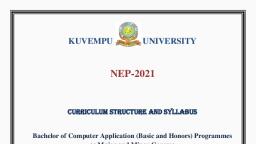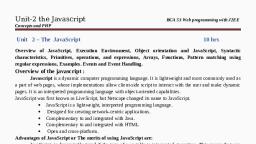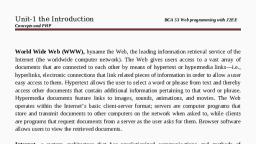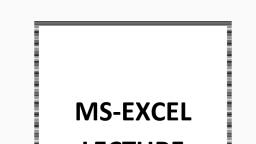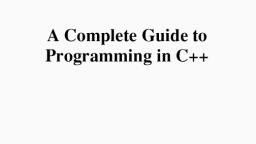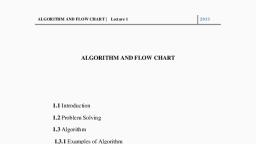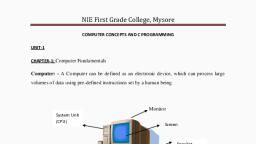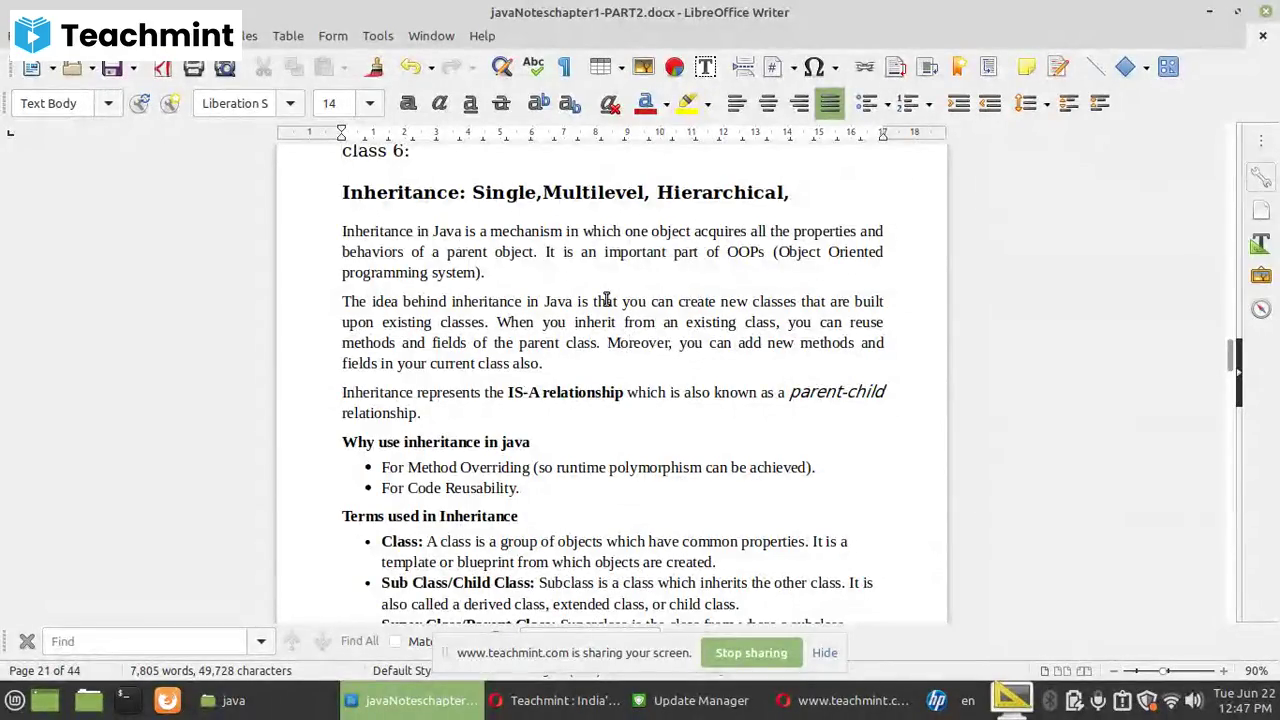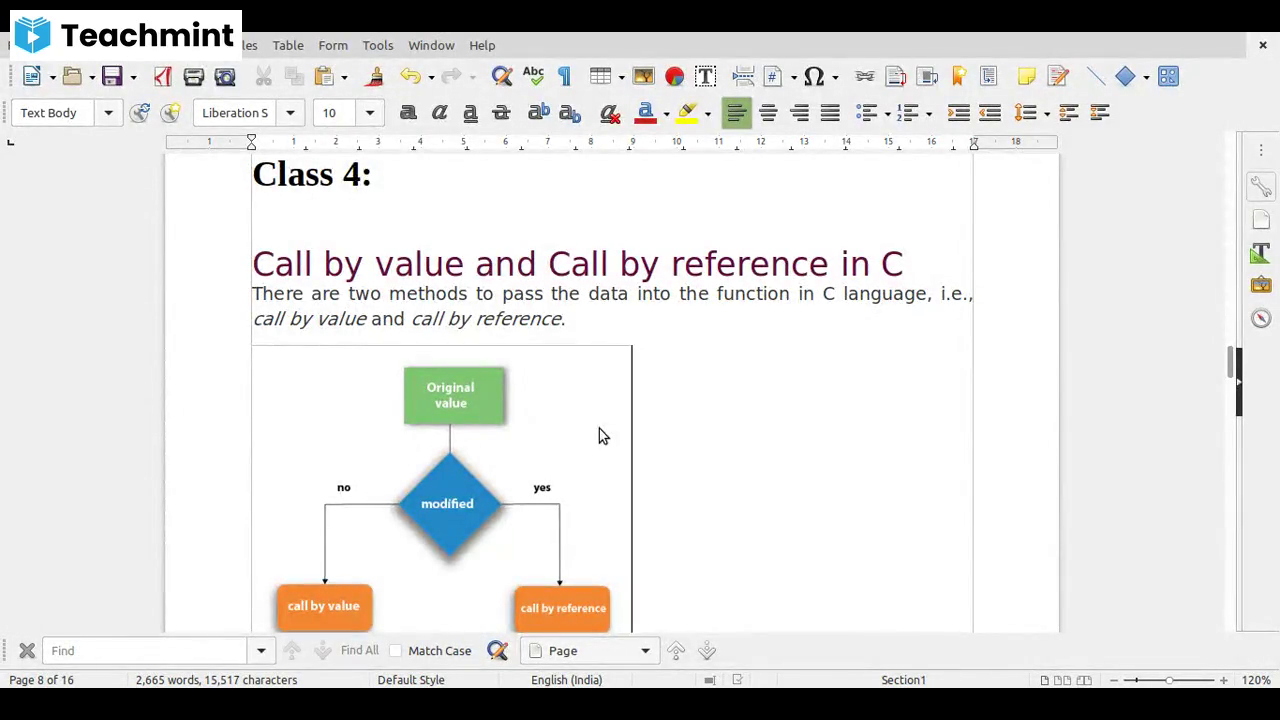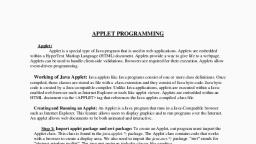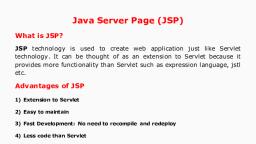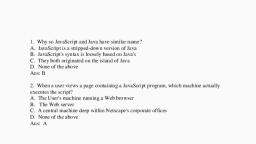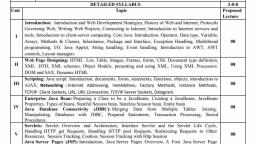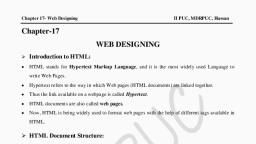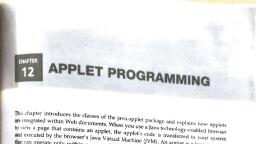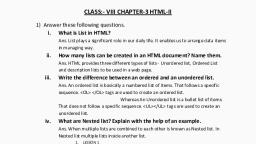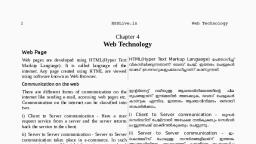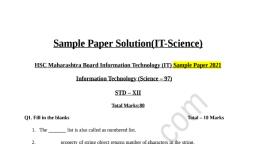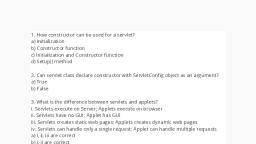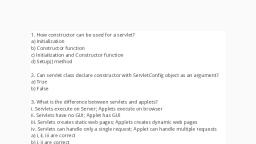Page 2 : JSP, , About the Tutorial, Java Server Pages (JSP) is a server-side programming technology that enables the, creation of dynamic, platform-independent method for building Web-based applications., JSP have access to the entire family of Java APIs, including the JDBC API to access, enterprise databases. This tutorial will teach you how to use Java Server Pages to develop, your web applications in simple and easy steps., , Audience, This tutorial has been prepared for the beginners to help them understand basic, functionality of Java Server Pages (JSP) to develop your web applications. After completing, this tutorial you will find yourself at a moderate level of expertise in using JSP from where, you can take yourself to next levels., , Prerequisites, We assume you have little knowledge of how web applications work over HTTP, what is, web server and what is web browsers. It will be great if you have some knowledge of web, application development using any programming language., , Copyright & Disclaimer, Copyright 2017 by Tutorials Point (I) Pvt. Ltd., All the content and graphics published in this e-book are the property of Tutorials Point (I), Pvt. Ltd. The user of this e-book is prohibited to reuse, retain, copy, distribute or republish, any contents or a part of contents of this e-book in any manner without written consent, of the publisher., We strive to update the contents of our website and tutorials as timely and as precisely as, possible, however, the contents may contain inaccuracies or errors. Tutorials Point (I) Pvt., Ltd. provides no guarantee regarding the accuracy, timeliness or completeness of our, website or its contents including this tutorial. If you discover any errors on our website or, in this tutorial, please notify us at
[email protected], , i
Page 3 :
JSP, , Table of Contents, About the Tutorial .................................................................................................................................... i, Audience .................................................................................................................................................. i, Prerequisites ............................................................................................................................................ i, Copyright & Disclaimer............................................................................................................................. i, Table of Contents .................................................................................................................................... ii, , JSP ─ OVERVIEW .................................................................................................................. 1, What is JavaServer Pages? ...................................................................................................................... 1, Why Use JSP? .......................................................................................................................................... 1, Advantages of JSP ................................................................................................................................... 2, What is Next? .......................................................................................................................................... 2, , JSP — ENVIRONMENT SETUP .............................................................................................. 3, Setting up Java Development Kit ............................................................................................................. 3, Setting up Web Server: Tomcat ............................................................................................................... 3, Setting up CLASSPATH ............................................................................................................................. 6, , JSP ─ ARCHITECTURE ........................................................................................................... 7, JSP Processing ......................................................................................................................................... 7, , JSP ─ LIFECYCLE ................................................................................................................... 9, Paths Followed By JSP ............................................................................................................................. 9, , JSP ─ SYNTAX ..................................................................................................................... 12, Elements of JSP ..................................................................................................................................... 12, , JSP ─ DIRECTIVES ............................................................................................................... 23, The page Directive ................................................................................................................................ 23, JSP - The page Directive......................................................................................................................... 25, ii
Page 4 :
JSP, , The include Directive ............................................................................................................................. 29, JSP - Include Directive ........................................................................................................................... 30, The taglib Directive ............................................................................................................................... 32, JSP - The taglib Directive ....................................................................................................................... 32, , JSP ─ ACTIONS ................................................................................................................... 34, Common Attributes............................................................................................................................... 34, The <jsp:include> Action ....................................................................................................................... 35, The <jsp:useBean> Action ..................................................................................................................... 36, The <jsp:setProperty> Action ................................................................................................................ 37, The <jsp:getProperty> Action ................................................................................................................ 38, The <jsp:forward> Action ...................................................................................................................... 40, The <jsp:plugin> Action ......................................................................................................................... 41, The <jsp:text> Action ............................................................................................................................ 42, , JSP ─ IMPLICIT OBJECTS ..................................................................................................... 44, JSP ─ CLIENT REQUEST....................................................................................................... 48, JSP ─ SERVER RESPONSE .................................................................................................... 54, JSP ─ HTTP STATUS CODES ................................................................................................ 60, Methods to Set HTTP Status Code ......................................................................................................... 64, HTTP Status Code Example .................................................................................................................... 64, , JSP ─ FORM PROCESSING .................................................................................................. 66, The Methods in Form Processing .......................................................................................................... 66, Reading Form Data using JSP ................................................................................................................. 66, GET Method Example Using URL ........................................................................................................... 67, GET Method Example Using Form ......................................................................................................... 68, POST Method Example Using Form ....................................................................................................... 68, iii
Page 5 :
JSP, , Passing Checkbox Data to JSP Program ................................................................................................. 70, Reading All Form Parameters ................................................................................................................ 72, , JSP ─ FILTERS ..................................................................................................................... 74, Servlet Filter Methods ........................................................................................................................... 74, JSP Filter Example ................................................................................................................................. 75, JSP Filter Mapping in Web.xml .............................................................................................................. 76, Using Multiple Filters ............................................................................................................................ 77, Filters Application Order ....................................................................................................................... 78, , JSP — COOKIES HANDLING ................................................................................................ 79, The Anatomy of a Cookie ...................................................................................................................... 79, Servlet Cookies Methods ....................................................................................................................... 80, Setting Cookies with JSP ........................................................................................................................ 81, Reading Cookies with JSP ...................................................................................................................... 83, Delete Cookies with JSP ........................................................................................................................ 85, , JSP — SESSION TRACKING ................................................................................................. 87, Maintaining Session Between Web Client And Server ........................................................................... 87, The session Object ................................................................................................................................ 88, Deleting Session Data ............................................................................................................................ 92, , JSP — FILE UPLOADING ..................................................................................................... 94, Creating a File Upload Form .................................................................................................................. 94, Writing Backend JSP Script .................................................................................................................... 95, , JSP — HANDLING DATE ..................................................................................................... 99, Getting Current Date & Time ............................................................................................................... 100, Date Comparison ................................................................................................................................ 101, Date Formatting using SimpleDateFormat .......................................................................................... 101, iv
Page 6 :
JSP, , Simple DateFormat Format Codes ....................................................................................................... 102, , JSP ─ PAGE REDIRECTING ................................................................................................ 104, JSP ─ HITS COUNTER ........................................................................................................ 106, Hit Counter Resets .............................................................................................................................. 107, , JSP ─ AUTO REFRESH ....................................................................................................... 108, Auto Page Refresh Example ................................................................................................................ 108, , JSP ─ SENDING EMAIL ...................................................................................................... 110, Send a Simple Email ............................................................................................................................ 110, Send an HTML Email ............................................................................................................................ 112, Send Attachment in Email ................................................................................................................... 114, User Authentication Part..................................................................................................................... 117, Using Forms to Send Email .................................................................................................................. 117, , JSP ─ STANDARD TAG LIBRARY (JSTL) TUTORIAL .............................................................. 119, Install JSTL Library ............................................................................................................................... 119, Classification of The JSTL Tags ............................................................................................................. 119, Core Tags............................................................................................................................................. 119, JSTL Core <c:out> Tag .......................................................................................................................... 121, JSTL Core <c:set> Tag ........................................................................................................................... 121, JSTL Core <c:remove> Tag ................................................................................................................... 122, JSTL Core <c:catch> Tag ....................................................................................................................... 124, JSTL Core <c:if> Tag ............................................................................................................................. 125, JSTL Core <c:choose>, <c:when>, <c:otherwise> Tag ........................................................................... 125, JSTL Core <c:choose>, <c:when>, <c:otherwise> Tag ........................................................................... 127, JSTL Core <c:choose>, <c:when>, <c:otherwise> Tag ........................................................................... 128, JSTL Core <c:import> Tag ..................................................................................................................... 129, v
Page 10 :
JSP, , JSP — EXPRESSION LANGUAGE (EL)................................................................................. 242, Simple Syntax ...................................................................................................................................... 242, Basic Operators in EL ........................................................................................................................... 243, Functions in JSP EL .............................................................................................................................. 244, JSP EL Implicit Objects ......................................................................................................................... 245, The pageContext Object ...................................................................................................................... 245, The Scope Objects ............................................................................................................................... 246, The param and paramValues Objects .................................................................................................. 246, header and headerValues Objects ....................................................................................................... 247, , JSP ─ EXCEPTION HANDLING ........................................................................................... 248, Using Exception Object ....................................................................................................................... 248, Using JSTL Tags for Error Page ............................................................................................................. 250, Using Try...Catch Block ........................................................................................................................ 252, , JSP — DEBUGGING .......................................................................................................... 253, Using System.out.println() .................................................................................................................. 253, Using the JDB Logger ........................................................................................................................... 254, Debugging Tools .................................................................................................................................. 256, Using JDB Debugger ............................................................................................................................ 257, Using Comments ................................................................................................................................. 257, Client and Server Headers ................................................................................................................... 257, , JSP — SECURITY............................................................................................................... 258, Role Based Authentication .................................................................................................................. 258, Form Based Authentication ................................................................................................................. 260, Programmatic Security in a Servlet/JSP ............................................................................................... 262, , ix
Page 11 :
JSP, , JSP — INTERNATIONALIZATION| I18N| L10N .................................................................. 263, Detecting Locale .................................................................................................................................. 263, Languages Setting ............................................................................................................................... 265, Locale Specific Dates ........................................................................................................................... 266, Locale Specific Currency ...................................................................................................................... 267, Locale Specific Percentage .................................................................................................................. 268, , x
Page 12 :
JSP ─ OVERVIEW, , JSP, , What is JavaServer Pages?, JavaServer Pages (JSP) is a technology for developing Webpages that supports dynamic, content. This helps developers insert java code in HTML pages by making use of special JSP, tags, most of which start with <% and end with %>., A JavaServer Pages component is a type of Java servlet that is designed to fulfill the role of, a user interface for a Java web application. Web developers write JSPs as text files that, combine HTML or XHTML code, XML elements, and embedded JSP actions and commands., Using JSP, you can collect input from users through Webpage forms, present records from a, database or another source, and create Webpages dynamically., JSP tags can be used for a variety of purposes, such as retrieving information from a database, or registering user preferences, accessing JavaBeans components, passing control between, pages, and sharing information between requests, pages etc., , Why Use JSP?, JavaServer Pages often serve the same purpose as programs implemented using the, Common Gateway Interface (CGI). But JSP offers several advantages in comparison with, the CGI., , , Performance is significantly better because JSP allows embedding Dynamic Elements, in HTML Pages itself instead of having separate CGI files., , , , JSP are always compiled before they are processed by the server unlike CGI/Perl which, requires the server to load an interpreter and the target script each time the page is, requested., , , , JavaServer Pages are built on top of the Java Servlets API, so like Servlets, JSP also, has access to all the powerful Enterprise Java APIs, including JDBC, JNDI, EJB, JAXP,, etc., , , , JSP pages can be used in combination with servlets that handle the business logic, the, model supported by Java servlet template engines., , Finally, JSP is an integral part of Java EE, a complete platform for enterprise class applications., This means that JSP can play a part in the simplest applications to the most complex and, demanding., , 11
Page 13 :
JSP, , Advantages of JSP, Following is the list of other advantages of using JSP over other technologies:, , vs. Active Server Pages (ASP), The advantages of JSP are twofold. First, the dynamic part is written in Java, not Visual Basic, or other MS specific language, so it is more powerful and easier to use. Second, it is portable, to other operating systems and non-Microsoft Web servers., , vs. Pure Servlets, It is more convenient to write (and to modify!) regular HTML than to have plenty of println, statements that generate the HTML., , vs. Server-Side Includes (SSI), SSI is really only intended for simple inclusions, not for "real" programs that use form data,, make database connections, and the like., , vs. JavaScript, JavaScript can generate HTML dynamically on the client but can hardly interact with the web, server to perform complex tasks like database access and image processing etc., , vs. Static HTML, Regular HTML, of course, cannot contain dynamic information., , What is Next?, I would take you step by step to set up your environment to start with JSP. I'm assuming you, have good hands-on with Java Programming to proceed with learning JSP., If you are not aware of Java Programming Language, then we would recommend you go, through our Java Tutorial to understand Java Programming., , 12
Page 14 :
JSP ─ ENVIRONMENT SETUP, , JSP, , A development environment is where you would develop your JSP programs, test them and, finally run them., This tutorial will guide you to setup your JSP development environment which involves the, following steps:, , Setting up Java Development Kit, This step involves downloading an implementation of the Java Software Development Kit, (SDK) and setting up the PATH environment variable appropriately., You can download SDK from Oracle's Java site: Java SE Downloads., Once you download your Java implementation, follow the given instructions to install and, configure the setup. Finally set the PATH and JAVA_HOME environment variables to refer, to the directory that contains java and javac, typically java_install_dir/bin and, java_install_dir respectively., If you are running Windows and install the SDK in C:\jdk1.5.0_20, you need to add the, following line in your C:\autoexec.bat file., set PATH=C:\jdk1.5.0_20\bin;%PATH%, set JAVA_HOME=C:\jdk1.5.0_20, Alternatively, on Windows NT/2000/XP, you can also right-click on My Computer, select, Properties, then Advanced, followed by Environment Variables. Then, you would update, the PATH value and press the OK button., On Unix (Solaris, Linux, etc.), if the SDK is installed in /usr/local/jdk1.5.0_20 and you use, the C shell, you will put the following into your .cshrc file., setenv PATH /usr/local/jdk1.5.0_20/bin:$PATH, setenv JAVA_HOME /usr/local/jdk1.5.0_20, Alternatively, if you use an Integrated Development Environment (IDE) like Borland, JBuilder, Eclipse, IntelliJ IDEA, or Sun ONE Studio, compile and run a simple program, to confirm that the IDE knows where you installed Java., , 13
Page 15 :
JSP, , Setting up Web Server: Tomcat, A number of Web Servers that support JavaServer Pages and Servlets development are, available in the market. Some web servers can be downloaded for free and Tomcat is one of, them., Apache Tomcat is an open source software implementation of the JavaServer Pages and, Servlet technologies and can act as a standalone server for testing JSP and Servlets, and can, be integrated with the Apache Web Server. Here are the steps to set up Tomcat on your, machine:, , , Download the latest version of Tomcat from http://tomcat.apache.org/., , , , Once you downloaded the installation, unpack the binary distribution into a convenient, location., For, example,, in, C:\apache-tomcat-5.5.29, on, windows,, or, /usr/local/apache-tomcat-5.5.29 on Linux/Unix and create CATALINA_HOME, environment variable pointing to these locations., , Tomcat can be started by executing the following commands on the Windows machine:, %CATALINA_HOME%\bin\startup.bat, , or, , C:\apache-tomcat-5.5.29\bin\startup.bat, Tomcat can be started by executing the following commands on the Unix (Solaris, Linux, etc.), machine:, $CATALINA_HOME/bin/startup.sh, , or, , /usr/local/apache-tomcat-5.5.29/bin/startup.sh, After a successful startup, the default web-applications included with Tomcat will be available, by visiting http://localhost:8080/., , 14
Page 16 :
JSP, Upon execution, you will receive the following output:, , Further information about configuring and running Tomcat can be found in the documentation, included here, as well as on the Tomcat web site: http://tomcat.apache.org, Tomcat can be stopped by executing the following commands on the Windows machine:, %CATALINA_HOME%\bin\shutdown, or, , C:\apache-tomcat-5.5.29\bin\shutdown, Tomcat can be stopped by executing the following commands on Unix (Solaris, Linux, etc.), machine:, $CATALINA_HOME/bin/shutdown.sh, , or, , 15
Page 17 :
JSP, , /usr/local/apache-tomcat-5.5.29/bin/shutdown.sh, , Setting up CLASSPATH, Since servlets are not part of the Java Platform, Standard Edition, you must identify the, servlet classes to the compiler., If you are running Windows, you need to put the following lines in your C:\autoexec.bat, file., set CATALINA=C:\apache-tomcat-5.5.29, set CLASSPATH=%CATALINA%\common\lib\jsp-api.jar;%CLASSPATH%, Alternatively, on Windows NT/2000/XP, you can also right-click on My Computer, select, Properties, then Advanced, then Environment Variables. Then, you would update the, CLASSPATH value and press the OK button., On Unix (Solaris, Linux, etc.), if you are using the C shell, you would put the following lines, into your .cshrc file., setenv CATALINA=/usr/local/apache-tomcat-5.5.29, setenv CLASSPATH $CATALINA/common/lib/jsp-api.jar:$CLASSPATH, NOTE: Assuming that your development directory is C:\JSPDev (Windows) or, /usr/JSPDev (Unix), then you would need to add these directories as well in CLASSPATH., , 16
Page 18 :
JSP ─ ARCHITECTURE, , JSP, , The web server needs a JSP engine, i.e., a container to process JSP pages. The JSP container, is responsible for intercepting requests for JSP pages. This tutorial makes use of Apache which, has built-in JSP container to support JSP pages development., A JSP container works with the Web server to provide the runtime environment and other, services a JSP needs. It knows how to understand the special elements that are part of JSPs., Following diagram shows the position of JSP container and JSP files in a Web application., , JSP Processing, The following steps explain how the web server creates the Webpage using JSP:, , , As with a normal page, your browser sends an HTTP request to the web server., , , , The web server recognizes that the HTTP request is for a JSP page and forwards it to, a JSP engine. This is done by using the URL or JSP page which ends with .jsp instead, of .html., , , , The JSP engine loads the JSP page from disk and converts it into a servlet content., This conversion is very simple in which all template text is converted to println( ), statements and all JSP elements are converted to Java code. This code implements, the corresponding dynamic behavior of the page., , , , The JSP engine compiles the servlet into an executable class and forwards the original, request to a servlet engine., 17
Page 19 :
JSP, , , A part of the web server called the servlet engine loads the Servlet class and executes, it. During execution, the servlet produces an output in HTML format. This output is, further passed on to the web server by the servlet engine inside an HTTP response., , , , The web server forwards the HTTP response to your browser in terms of static HTML, content., , , , Finally, the web browser handles the dynamically-generated HTML page inside the, HTTP response exactly as if it were a static page., , All the above mentioned steps can be seen in the following diagram:, , Typically, the JSP engine checks to see whether a servlet for a JSP file already exists and, whether the modification date on the JSP is older than the servlet. If the JSP is older than its, generated servlet, the JSP container assumes that the JSP hasn't changed and that the, generated servlet still matches the JSP's contents. This makes the process more efficient than, with the other scripting languages (such as PHP) and therefore faster., So in a way, a JSP page is really just another way to write a servlet without having to be a, Java programming wiz. Except for the translation phase, a JSP page is handled exactly like a, regular servlet, , 18
Page 20 :
JSP ─ LIFECYCLE, , JSP, , In this chapter, we will discuss the lifecycle of JSP. The key to understanding the low-level, functionality of JSP is to understand the simple life cycle they follow., A JSP life cycle is defined as the process from its creation till the destruction. This is similar, to a servlet life cycle with an additional step which is required to compile a JSP into servlet., , Paths Followed By JSP, The following are the paths followed by a JSP, , , Compilation, , , , Initialization, , , , Execution, , , , Cleanup, , The four major phases of a JSP life cycle are very similar to the Servlet Life Cycle. The four, phases have been described below:, , 19
Page 21 :
JSP, , JSP Compilation, When a browser asks for a JSP, the JSP engine first checks to see whether it needs to compile, the page. If the page has never been compiled, or if the JSP has been modified since it was, last compiled, the JSP engine compiles the page., The compilation process involves three steps:, , , Parsing the JSP., , , , Turning the JSP into a servlet., , , , Compiling the servlet., , JSP Initialization, When a container loads a JSP it invokes the jspInit() method before servicing any requests., If you need to perform JSP-specific initialization, override the jspInit() method:, public void jspInit(){, // Initialization code..., }, Typically, initialization is performed only once and as with the servlet init method, you, generally initialize database connections, open files, and create lookup tables in the jspInit, method., , JSP Execution, This phase of the JSP life cycle represents all interactions with requests until the JSP is, destroyed., Whenever a browser requests a JSP and the page has been loaded and initialized, the JSP, engine invokes the _jspService() method in the JSP., The _jspService() method takes an HttpServletRequest and an HttpServletResponse as, its parameters as follows:, void _jspService(HttpServletRequest request,, HttpServletResponse response), {, // Service handling code..., }, , 20
Page 22 :
JSP, The _jspService() method of a JSP is invoked on request basis. This is responsible for, generating the response for that request and this method is also responsible for generating, responses to all seven of the HTTP methods, i.e., GET, POST, DELETE, etc., , JSP Cleanup, The destruction phase of the JSP life cycle represents when a JSP is being removed from use, by a container., The jspDestroy() method is the JSP equivalent of the destroy method for servlets. Override, jspDestroy when you need to perform any cleanup, such as releasing database connections, or closing open files., The jspDestroy() method has the following form:, public void jspDestroy(), {, // Your cleanup code goes here., }, , 21
Page 23 :
JSP ─ SYNTAX, , JSP, , In this chapter, we will discuss Syntax in JSP. We will understand the basic use of simple, syntax (i.e., elements) involved with JSP development., , Elements of JSP, The elements of JSP have been described below:, , The Scriptlet, A scriptlet can contain any number of JAVA language statements, variable or method, declarations, or expressions that are valid in the page scripting language., Following is the syntax of Scriptlet:, <% code fragment %>, You can write the XML equivalent of the above syntax as follows:, <jsp:scriptlet>, code fragment, </jsp:scriptlet>, Any text, HTML tags, or JSP elements you write must be outside the scriptlet. Following is the, simple and first example for JSP:, <html>, <head><title>Hello World</title></head>, <body>, Hello World!<br/>, <%, out.println("Your IP address is " + request.getRemoteAddr());, %>, </body>, </html>, , 22
Page 24 :
JSP, NOTE: Assuming that Apache Tomcat is installed in C:\apache-tomcat-7.0.2 and your, environment is setup as per environment setup tutorial., Let us keep the above code in JSP file hello.jsp and put this file in C:\apache-tomcat7.0.2\webapps\ROOT directory., Browse, through, the, same, using, URL, http://localhost:8080/hello.jsp. This would generate the following result:, , JSP Declarations, A declaration declares one or more variables or methods that you can use in Java code later, in the JSP file. You must declare the variable or method before you use it in the JSP file., Following is the syntax for JSP Declarations:, <%! declaration; [ declaration; ]+ ... %>, You can write the XML equivalent of the above syntax as follows:, <jsp:declaration>, code fragment, </jsp:declaration>, Following is an example for JSP Declarations:, <%! int i = 0; %>, <%! int a, b, c; %>, <%! Circle a = new Circle(2.0); %>, , JSP Expression, A JSP expression element contains a scripting language expression that is evaluated,, converted to a String, and inserted where the expression appears in the JSP file., , 23
Page 25 :
JSP, Because the value of an expression is converted to a String, you can use an expression within, a line of text, whether or not it is tagged with HTML, in a JSP file., The expression element can contain any expression that is valid according to the Java, Language Specification but you cannot use a semicolon to end an expression., Following is the syntax of JSP Expression:, <%= expression %>, , You can write the XML equivalent of the above syntax as follows:, <jsp:expression>, expression, </jsp:expression>, Following example shows a JSP Expression:, <html>, <head><title>A Comment Test</title></head>, <body>, <p>, Today's date: <%= (new java.util.Date()).toLocaleString()%>, </p>, </body>, </html>, The above code will generate the following result:, , JSP Comments, JSP comment marks the text or the statements that the JSP container should ignore. A JSP, comment is useful when you want to hide or "comment out", a part of your JSP page., 24
Page 26 :
JSP, Following is the syntax of the JSP comments:, <%-- This is JSP comment --%>, Following example shows the JSP Comments:, <html>, <head><title>A Comment Test</title></head>, <body>, <h2>A Test of Comments</h2>, <%-- This comment will not be visible in the page source --%>, </body>, </html>, , The above code will generate the following result:, , There are a small number of special constructs you can use in various cases to insert, comments or characters that would otherwise be treated specially. Here's a summary:, Syntax, , Purpose, , <%-- comment --%>, , A JSP comment. Ignored by the JSP engine., , <!-- comment -->, , An HTML comment. Ignored by the browser., , <\%, , Represents static <% literal., , %\>, , Represents static %> literal., , \', , A single quote in an attribute that uses single quotes., , \", , A double quote in an attribute that uses double quotes., 25
Page 27 :
JSP, , JSP Directives, A JSP directive affects the overall structure of the servlet class. It usually has the following, form:, <%@ directive attribute="value" %>, There are three types of directive tag:, Directive, , Description, , <%@ page ... %>, , Defines page-dependent attributes, such as scripting, language, error page, and buffering requirements., , <%@ include ... %>, , <%@ taglib ... %>, , Includes a file during the translation phase., Declares a tag library, containing custom actions, used in the, page, , We would explain the JSP directive in a separate chapter — JSP - Directives, , JSP Actions, JSP actions use constructs in XML syntax to control the behavior of the servlet engine. You, can dynamically insert a file, reuse JavaBeans components, forward the user to another page,, or generate HTML for the Java plugin., There is only one syntax for the Action element, as it conforms to the XML standard:, <jsp:action_name attribute="value" />, Action elements are basically predefined functions. Following table lists out the available JSP, Actions:, Syntax, jsp:include, jsp:useBean, , Purpose, Includes a file at the time the page is requested., Finds or instantiates a JavaBean., , 26
Page 28 :
JSP, , jsp:setProperty, , Sets the property of a JavaBean., , jsp:getProperty, , Inserts the property of a JavaBean into the output., , jsp:forward, jsp:plugin, , Forwards the requester to a new page., Generates browser-specific code that makes an OBJECT or, EMBED tag for the Java plugin., , jsp:element, , Defines XML elements dynamically., , jsp:attribute, , Defines dynamically-defined XML element's attribute., , jsp:body, , Defines dynamically-defined XML element's body., , jsp:text, , Used to write template text in JSP pages and documents., , We would explain JSP actions in a separate chapter — JSP - Actions, , 27
Page 29 :
JSP, , JSP Implicit Objects, JSP supports nine automatically defined variables, which are also called implicit objects. These, variables are:, , Objects, , Description, , request, , This is the HttpServletRequest object associated with the, request., , response, , This is the HttpServletResponse object associated with the, response to the client., , out, , This is the PrintWriter object used to send output to the, client., , session, , This is the HttpSession object associated with the request., , application, , config, , This, is, the ServletContext object, application context., , associated, , with, , This is the ServletConfig object associated with the page., , pageContext, , This encapsulates use of server-specific features like higher, performance JspWriters., , page, , This is simply a synonym for this, and is used to call the, methods defined by the translated servlet class., , Exception, , The Exception object allows the exception data to be, accessed by designated JSP., 28
Page 31 :
JSP, , Control-Flow Statements, You can use all the APIs and building blocks of Java in your JSP programming including, decision-making statements, loops, etc., , Decision-Making Statements, The if...else block starts out like an ordinary Scriptlet, but the Scriptlet is closed at each line, with HTML text included between the Scriptlet tags., <%! int day = 3; %>, <html>, <head><title>IF...ELSE Example</title></head>, <body>, <% if (day == 1 | day == 7) { %>, <p> Today is weekend</p>, <% } else { %>, <p> Today is not weekend</p>, <% } %>, </body>, </html>, The above code will generate the following result:, , Now look at the following switch...case block which has been written a bit differentlty, using out.println() and inside Scriptletas:, <%! int day = 3; %>, <html>, <head><title>SWITCH...CASE Example</title></head>, <body>, <%, switch(day) {, case 0:, out.println("It\'s Sunday.");, 30
Page 32 :
JSP, , break;, case 1:, out.println("It\'s Monday.");, break;, case 2:, out.println("It\'s Tuesday.");, break;, case 3:, out.println("It\'s Wednesday.");, break;, case 4:, out.println("It\'s Thursday.");, break;, case 5:, out.println("It\'s Friday.");, break;, default:, out.println("It's Saturday.");, }, %>, </body>, </html>, The above code will generate the following result:, , Loop Statements, You can also use three basic types of looping blocks in Java: for, while,and do…while blocks, in your JSP programming., Let us look at the following for loop example:, <%! int fontSize; %>, 31
Page 34 :
JSP, , </font><br />, <%fontSize++;%>, <%}%>, </body>, </html>, The above code will generate the following result:, , JSP Operators, JSP supports all the logical and arithmetic operators supported by Java. Following table lists, out all the operators with the highest precedence appear at the top of the table, those with, the lowest appear at the bottom., Within an expression, higher precedence operators will be evaluated first., Category, , Operator, , Associativity, , Postfix, , () [] . (dot operator), , Left to right, , Unary, , ++ - - ! ~, , Right to left, , Multiplicative, , */%, , Left to right, , Additive, , +-, , Left to right, , Shift, , >> >>> <<, , Left to right, , 33
Page 35 :
JSP, , Relational, , > >= < <=, , Left to right, , Equality, , == !=, , Left to right, , Bitwise AND, , &, , Left to right, , Bitwise XOR, , ^, , Left to right, , Bitwise OR, , |, , Left to right, , Logical AND, , &&, , Left to right, , Logical OR, , ||, , Left to right, , Conditional, , ?:, , Right to left, , Assignment, , = += -= *= /= %= >>=, <<= &= ^= |=, , Right to left, , Comma, , ,, , Left to right, , JSP Literals, The JSP expression language defines the following literals:, , , Boolean: true and false, , , , Integer: as in Java, , , , Floating point: as in Java, , , , String: with single and double quotes; " is escaped as \", ' is escaped as \', and \ is, escaped as \\., , , , Null: null, , 34
Page 36 :
JSP ─ DIRECTIVES, , JSP, , In this chapter, we will discuss Directives in JSP. These directives provide directions and, instructions to the container, telling it how to handle certain aspects of the JSP processing., A JSP directive affects the overall structure of the servlet class. It usually has the following, form:, <%@ directive attribute="value" %>, Directives can have a number of attributes which you can list down as key-value pairs and, separated by commas., The blanks between the @ symbol and the directive name, and between the last attribute and, the closing %>, are optional., There are three types of directive tag:, Directive, , Description, , <%@ page ... %>, , Defines page-dependent attributes, such as scripting, language, error page, and buffering requirements., , <%@ include ... %>, , Includes a file during the translation phase., , <%@ taglib ... %>, , Declares a tag library, containing custom actions, used in the, page, , The page Directive, The page directive is used to provide instructions to the container. These instructions pertain, to the current JSP page. You may code page directives anywhere in your JSP page. By, convention, page directives are coded at the top of the JSP page., Following is the basic syntax of the page directive:, <%@ page attribute="value" %>, You can write the XML equivalent of the above syntax as follows:, 35
Page 37 :
JSP, , <jsp:directive.page attribute="value" />, , Attributes, Following table lists out the attributes associated with page directive:, Attribute, , Purpose, , buffer, , Specifies a buffering model for the output stream., , autoFlush, , Controls the behavior of the servlet output buffer., , contentType, , Defines the character encoding scheme., , errorPage, , Defines the URL of another JSP that reports on Java, unchecked runtime exceptions., , isErrorPage, , Indicates if this JSP page is a URL specified by another JSP, page's errorPage attribute., , extends, , Specifies a superclass that the generated servlet must, extend., , import, , Specifies a list of packages or classes for use in the JSP as, the Java import statement does for Java classes., , info, , Defines a string that can be accessed with the servlet's, getServletInfo() method., , isThreadSafe, language, , session, , Defines the threading model for the generated servlet., Defines the programming language used in the JSP page., Specifies whether or not the JSP page participates in HTTP, sessions, 36
Page 38 :
JSP, , isELIgnored, , isScriptingEnabled, , Specifies whether or not the EL expression within the JSP, page will be ignored., Determines if the scripting elements are allowed for use., , Check for more details related to all the above attributes at Page Directive., , JSP - The page Directive, The page directive is used to provide instructions to the container that pertain to the current, JSP page. You may code the page directives anywhere in your JSP page. By convention, page, directives are coded at the top of the JSP page., Following is the basic syntax of page directive:, <%@ page attribute="value" %>, You can write the XML equivalent of the above syntax as follows:, <jsp:directive.page attribute="value" />, , Attributes, Following table lists out the attributes associated with the page directive:, Attribute, , Purpose, , buffer, , Specifies a buffering model for the output stream., , autoFlush, , Controls the behavior of the servlet output buffer., , contentType, , Defines the character encoding scheme., , errorPage, , Defines the URL of another JSP that reports on Java, unchecked runtime exceptions., , isErrorPage, , Indicates if this JSP page is a URL specified by another JSP, page's errorPage attribute., , 37
Page 39 :
JSP, , extends, , Specifies a superclass that the generated servlet must, extend., , import, , Specifies a list of packages or classes for use in the JSP as, the Java import statement does for Java classes., , info, , Defines a string that can be accessed with the servlet's, getServletInfo() method., , isThreadSafe, language, , Defines the threading model for the generated servlet., Defines the programming language used in the JSP page., , session, , Specifies whether or not the JSP page participates in HTTP, sessions., , isELIgnored, , Specifies whether or not the EL expression within the JSP, page will be ignored., , isScriptingEnabled, , Determines if the scripting elements are allowed for use., , The buffer Attribute, The buffer attribute specifies the buffering characteristics for the server output response, object., You may code a value of "none" to specify no buffering so that the servlet output is, immediately directed to the response object or you may code a maximum buffer size in, kilobytes, which directs the servlet to write to the buffer before writing to the response object., To direct the servlet to write the output directly to the response output object, use the, following:, <%@ page buffer="none" %>, Use the following to direct the servlet to write the output to a buffer of size not less than 8, kilobytes:, <%@ page buffer="8kb" %>, , The autoFlush Attribute, 38
Page 40 :
JSP, The autoFlush attribute specifies whether buffered output should be flushed automatically, when the buffer is filled, or whether an exception should be raised to indicate the buffer, overflow., A value of true (default) indicates automatic buffer flushing and a value of false throws an, exception., The following directive causes the servlet to throw an exception when the servlet's output, buffer is full:, <%@ page autoFlush="false" %>, This directive causes the servlet to flush the output buffer when full:, <%@ page autoFlush="true" %>, , Usually, the buffer and the autoFlush attributes are coded on a single page directive as, follows:, <%@ page buffer="16kb" autoflush="true" %>, , The contentType Attribute, The contentType attribute sets the character encoding for the JSP page and for the generated, response page. The default content type is text/html, which is the standard content type for, HTML pages., If you want to write out XML from your JSP, use the following page directive:, <%@ page contentType="text/xml" %>, The following statement directs the browser to render the generated page as HTML:, <%@ page contentType="text/html" %>, The following directive sets the content type as a Microsoft Word document:, <%@ page contentType="application/msword" %>, You can also specify the character encoding for the response. For example, if you wanted to, specify that the resulting page that is returned to the browser uses ISO Latin 1, you can use, the following page directive:, 39
Page 41 :
JSP, , <%@ page contentType="text/html:charset=ISO-8859-1" %>, , The errorPage Attribute, The errorPage attribute tells the JSP engine which page to display if there is an error while, the current page runs. The value of the errorPage attribute is a relative URL., The following directive displays MyErrorPage.jsp when all uncaught exceptions are thrown:, <%@ page errorPage="MyErrorPage.jsp" %>, , The isErrorPage Attribute, The isErrorPage attribute indicates that the current JSP can be used as the error page for, another JSP., The value of isErrorPage is either true or false. The default value of the isErrorPage attribute, is false., For example, the handleError.jsp sets the isErrorPage option to true because it is supposed, to handle errors:, <%@ page isErrorPage="true" %>, , The extends Attribute, The extends attribute specifies a superclass that the generated servlet must extend., For example, the following directive directs the JSP translator to generate the servlet such, that the servlet extends somePackage.SomeClass:, <%@ page extends="somePackage.SomeClass" %>, , The import Attribute, The import attribute serves the same function as, and behaves like, the Java import, statement. The value for the import option is the name of the package you want to import., To import java.sql.*, use the following page directive:, <%@ page import="java.sql.*" %>, To import multiple packages, you can specify them separated by comma as follows:, <%@ page import="java.sql.*,java.util.*", , %>, 40
Page 42 :
JSP, By, default,, a, container automatically imports, javax.servlet.jsp.*, and javax.servlet.http.*., , java.lang.*,, , javax.servlet.*,, , The info Attribute, The info attribute lets you provide a description of the JSP. The following is a coding example:, <%@ page info="This JSP Page Written By ZARA", , %>, , The isThreadSafe Attribute, The isThreadSafe option marks a page as being thread-safe. By default, all JSPs are, considered thread-safe. If you set the isThreadSafe option to false, the JSP engine makes, sure that only one thread at a time is executing your JSP., The following page directive sets the isThreadSafe option to false:, <%@ page isThreadSafe="false", , %>, , The language Attribute, The language attribute indicates the programming language used in scripting the JSP page., For example, because you usually use Java as the scripting language, your language option, looks like this:, <%@ page language="java" %>, , The session Attribute, The session attribute indicates whether or not the JSP page uses HTTP sessions. A value of, true means that the JSP page has access to a builtin session object and a value of false, means that the JSP page cannot access the builtin session object., Following directive allows the JSP page to use any of the builtin object session methods such, as session.getCreationTime() or session.getLastAccessTime():, <%@ page session="true" %>, , The isELIgnored Attribute, The isELIgnored attribute gives you the ability to disable the evaluation of Expression, Language (EL) expressions which has been introduced in JSP 2.0., The default value of the attribute is true, meaning that expressions, ${...}, are evaluated as, dictated by the JSP specification. If the attribute is set to false, then expressions are not, evaluated but rather treated as static text., 41
Page 43 :
JSP, Following directive sets an expression not to be evaluated:, <%@ page isELIgnored="false" %>, , The isScriptingEnabled Attribute, The isScriptingEnabled attribute determines if the scripting elements are allowed for use., The default value (true) enables scriptlets, expressions, and declarations. If the attribute's, value is set to false, a translation-time error will be raised if the JSP uses any scriptlets,, expressions (non-EL), or declarations., The attribute’s value can be set to false if you want to restrict the usage of scriptlets,, expressions (non-EL), or declarations:, <%@ page isScriptingEnabled="false" %>, , The include Directive, The include directive is used to include a file during the translation phase. This directive tells, the container to merge the content of other external files with the current JSP during the, translation phase. You may code the include directives anywhere in your JSP page., The general usage form of this directive is as follows:, <%@ include file="relative url" >, The filename in the include directive is actually a relative URL. If you just specify a filename, with no associated path, the JSP compiler assumes that the file is in the same directory as, your JSP., You can write the XML equivalent of the above syntax as follows:, <jsp:directive.include file="relative url" />, For more details related to include directive, check the Include Directive., , JSP - Include Directive, The include directive is used to include a file during the translation phase. This directive tells, the container to merge the content of other external files with the current JSP during the, translation phase. You may code include directives anywhere in your JSP page., The general usage form of this directive is as follows:, <%@ include file="relative url" >, 42
Page 44 :
JSP, The filename in the include directive is actually a relative URL. If you just specify a filename, with no associated path, the JSP compiler assumes that the file is in the same directory as, your JSP., You can write the XML equivalent of the above syntax as follows:, <jsp:directive.include file="relative url" />, , Example, A good example of the include directive is including a common header and footer with, multiple pages of content., Let us define following three files (a) header.jps, (b)footer.jsp, and (c)main.jsp as, follows:, Following is the content of header.jsp:, <%!, int pageCount = 0;, void addCount() {, pageCount++;, }, %>, <% addCount(); %>, <html>, <head>, <title>The include Directive Example</title>, </head>, <body>, <center>, <h2>The include Directive Example</h2>, <p>This site has been visited <%= pageCount %> times.</p>, </center>, <br/><br/>, Following is the content of footer.jsp:, <%@ include file="header.jsp" %>, <center>, 43
Page 45 :
JSP, , <p>Thanks for visiting my page.</p>, </center>, <%@ include file="footer.jsp" %>, Let us now keep all these files in the root directory and try to access main.jsp. You will, receive the following output:, , Refresh main.jsp and you will find that the page hit counter keeps increasing., You can design your webpages based on your creative instincts; it is recommended you keep, the dynamic parts of your website in separate files and then include them in the main file., This makes it easy when you need to change a part of your webpage., , The taglib Directive, The JavaServer Pages API allow you to define custom JSP tags that look like HTML or XML, tags and a tag library is a set of user-defined tags that implement custom behavior., 44
Page 46 :
JSP, The taglib directive declares that your JSP page uses a set of custom tags, identifies the, location of the library, and provides means for identifying the custom tags in your JSP page., The taglib directive follows the syntax given below:, <%@ taglib uri="uri" prefix="prefixOfTag" >, Here, the uri attribute value resolves to a location the container understands and, the prefix attribute informs a container what bits of markup are custom actions., You can write the XML equivalent of the above syntax as follows:, <jsp:directive.taglib uri="uri" prefix="prefixOfTag" />, For more details related to the taglib directive, check the Taglib Directive., , JSP - The taglib Directive, The JavaServer Pages API allows you to define custom JSP tags that look like HTML or XML, tags and a tag library is a set of user-defined tags that implement custom behavior., The taglib directive declares that your JSP page uses a set of custom tags, identifies the, location of the library, and provides a means for identifying the custom tags in your JSP page., The taglib directive follows the syntax given below:, <%@ taglib uri="uri" prefix="prefixOfTag" >, Where the uri attribute value resolves to a location the container understands and, the prefix attribute informs a container what bits of markup are custom actions., You can write the XML equivalent of the above syntax as follows:, <jsp:directive.taglib uri="uri" prefix="prefixOfTag" />, When you use a custom tag, it is typically of the form <prefix:tagname>. The prefix is the, same as the prefix you specify in the taglib directive, and the tagname is the name of a tag, implemented in the tag library., , Example, For example, suppose the custlib tag library contains a tag called hello. If you wanted to, use the hello tag with a prefix of mytag, your tag would be <mytag:hello> and it will be, used in your JSP file as follows:, <%@ taglib uri="http://www.example.com/custlib" prefix="mytag" %>, <html>, 45
Page 47 :
JSP, , <body>, <mytag:hello/>, </body>, </html>, We can call another piece of code using <mytag:hello>. We will see how to develop our, custom tags and how to use them in JSP - Custom Tags tutorial., , 46
Page 48 :
JSP, End of ebook preview, If you liked what you saw…, Buy it from our store @ https://store.tutorialspoint.com, , 47





